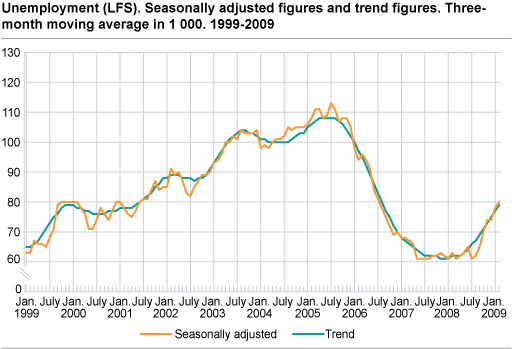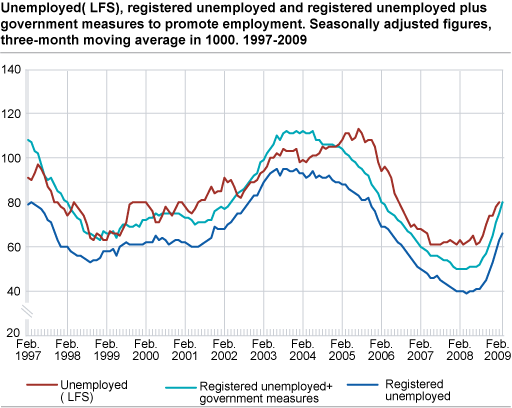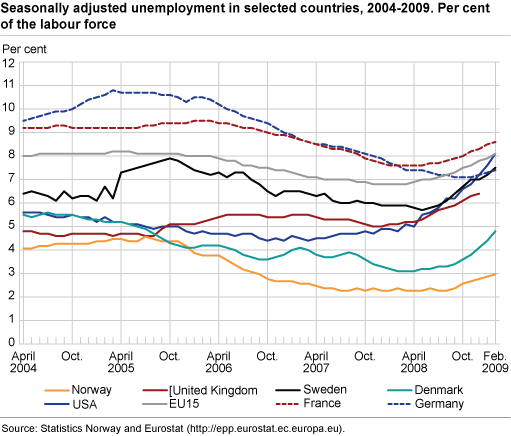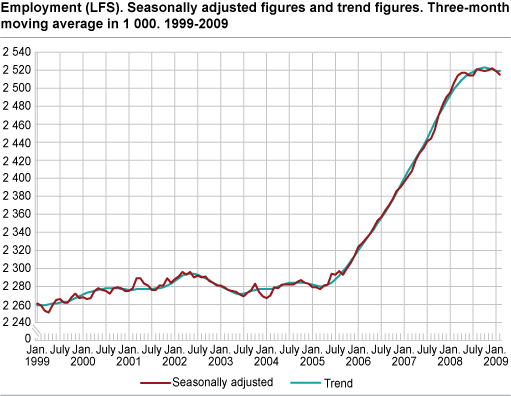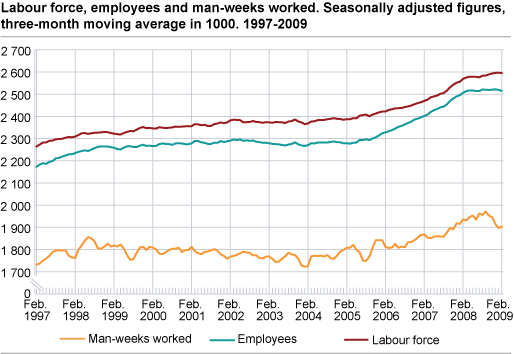Content
Published:
This is an archived release.
Rising unemployment
Unemployment was up by 6 000 from November 2008 to February 2009. The unemployment was 3.1 per cent in February after a new adjustment to international recommendations for the definition of unemployment. Without this adjustment, the unemployment would have been 3.3 per cent.
Change in the definition of unemploymentThe EU and the ILO (International Labour Organisation) recommend that persons laid off are defined as employed during the first three months of leave and thereafter as unemployed. In Norway, they have been defined as unemployed after one week. After a major change in the LFS in 2006, the figures, not seasonally adjusted, were adapted in line with the new international recommendations. Longer time series are needed to calculate seasonally-adjusted figures, so the adjustment to the new definition has only now been carried out. Seasonally-adjusted figures dating back to 1997 have been adjusted to the new definition. The level of unemployment is slightly lower and employment has correspondingly increased. |
The unemployment rate with the new definition increased from 2.8 per cent of the labour force in November (as measured by the average of the three months from October to December) to 3.1 per cent in February (as measured by the average of the three months from January to March). Most of the increase was among people aged 25-74.
Seasonally-adjusted figures for people registered unemployed and on government initiatives to promote employment with the Labour and Welfare Organisation (NAV) increased by 14 000 from November to February. The most important reason explaining the higher increase in registered employment than for unemployment in the LFS is that some of these people are counted as employed in the LFS, for example those laid off less than three months.
|
NAV reports that 4 700 persons were incorrectly registered unemployed in February 2010. The erroneous figure was lower in previous months, but dates back to October 2008.This has no consequence for the LFS-numbers published by Statistics Norway, only for the comparisons with NAV's figures. Read more on NAV's website, or contact stein.langeland@nav.no |
Unemployment up in many countries
Unemployment increased in many countries from November to February, including the USA, Sweden, Denmark, France and Germany. All figures refer to seasonally-adjusted data from Eurostat .
Stable employment
Adjusted for seasonal variations, the Labour Force Survey (LFS) shows that the number in employment decreased by 4 000 from November (as measured by the average of the three months from October to December) to February (as measured by the average of the three months from January to March). This is inside the error margin, and when taking the error margin into account, employment has been stable since April 2008.
Man-weeks worked
From November to February, the average number of man-weeks (37.5 hours) worked each week decreased by 43 000. With New Year’s Eve being on a Wednesday in the first week of January, it seems that people took more days off this week than usual, and this may partly explain the large decline in man-weeks worked.
Employment and unemployment figures include permanent residentsThe LFS only includes persons who are registered as residents in the population register. Persons working in Norway but who are not registered as permanent residents or who are planning to stay for less than six months are not included in the number in employment in the LFS. If these people lose their job, it does not count as a fall in employment or a rise in unemployment. In national accounts figures (NR), employed non-residents are included in the employment figure as long as they work in an establishment in Norway. If employment decreases in this group, it will count as a fall in employment in NR. Statistics Norway publishes separate figures for all registered non-residents once a year. See short-term immigrants . |
Uncertain figuresThe purpose of making seasonal adjustments is to describe the development over the last year, corrected for seasonal variations. In order to reduce uncertainty, the published series are three-month moving averages of the seasonally-adjusted figures. However, uncertainty means that sampling errors must be considered when interpreting the figures from the LFS. We normally compare the latest non-overlapping three-month periods. An overview of sampling errors in the LFS can be found in “ About the statistics ”, chapter 5 section 3. Quarterly LFS figures, not seasonally adjusted, are presented in a separate article . |
RevisionsThe complete time series is re-estimated each month, and this may cause some adjustments of previously published figures. See Revisions for more information . |
Tables:
The statistics is published with Labour force survey.
Contact
-
Arbeidsmarked og lønn
E-mail: arbeidsmarked@ssb.no
-
Erik Herstad Horgen
E-mail: erik.horgen@ssb.no
tel.: (+47) 93 08 68 62

